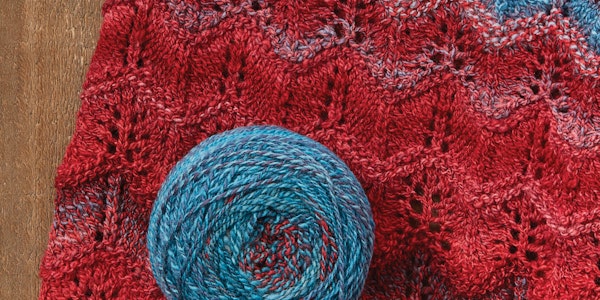Subscriber Exclusive
Wool into Stone Afghan
Inspired by wool’s natural colors, Amy Tyler interpreted the fossilized coral Petoskey stones as a modular throw.
When a friend offered me ten raw Shetland wool fleeces of various colors, my exact words were, “Heck, yes!” Although the fiber was a nice quality—soft, with an even crimp—the fleeces had vegetable matter, dirty bits, and second cuts. After two days picking over the fleeces, I took them to Stonehedge Fiber Mill. Gathered all together, the fleeces looked remarkably similar to the colors of Petoskey stones.
The Petoskey stone, Hexagonaria percarinata, is the official state stone of Michigan. It derives its name from the Odawa word petosegay, which translates to “sunbeams of promise.” Although Petoskey stones can be found outside of Michigan, the finest examples are most plentiful in northwestern lower Michigan. This stone is a type of fossilized coral with a distinctive design of roughly hexagonal elements, round centers, and radiating lines that go out to a light-colored edge. The colors vary, but they are all in the black/gray/white direction.
I used the ten rovings to create my first Petoskey project, a wall hanging. After finishing the wall hanging, I created afghans for my sisters, Meg and Jo.
The important elements of a knitted Petoskey stone include a nonuniform shape, allowing four- to nine-sided polygons; a circular center that is usually darker than the outer edge; lines that start outside the circular center and radiate outward to the border; and a light-colored border.
Each of the medallions that make up these afghans is knitted in a circle from two to three colors. The rough hexagonal shapes that result are due to the way the medallions are crocheted together and some strong blocking of the final piece. The center portion of each circle is worked in garter stitch to accentuate the shape, and on the outer portion, a two-stitch twist on a background of reverse stockinette mimics the radiating lines in Petoskey stones. The white yarn is reserved for the border of each medallion and for crocheting the medallions together.
When a friend offered me ten raw Shetland wool fleeces of various colors, my exact words were, “Heck, yes!” Although the fiber was a nice quality—soft, with an even crimp—the fleeces had vegetable matter, dirty bits, and second cuts. After two days picking over the fleeces, I took them to Stonehedge Fiber Mill. Gathered all together, the fleeces looked remarkably similar to the colors of Petoskey stones.
The Petoskey stone, Hexagonaria percarinata, is the official state stone of Michigan. It derives its name from the Odawa word petosegay, which translates to “sunbeams of promise.” Although Petoskey stones can be found outside of Michigan, the finest examples are most plentiful in northwestern lower Michigan. This stone is a type of fossilized coral with a distinctive design of roughly hexagonal elements, round centers, and radiating lines that go out to a light-colored edge. The colors vary, but they are all in the black/gray/white direction.
I used the ten rovings to create my first Petoskey project, a wall hanging. After finishing the wall hanging, I created afghans for my sisters, Meg and Jo.
The important elements of a knitted Petoskey stone include a nonuniform shape, allowing four- to nine-sided polygons; a circular center that is usually darker than the outer edge; lines that start outside the circular center and radiate outward to the border; and a light-colored border.
Each of the medallions that make up these afghans is knitted in a circle from two to three colors. The rough hexagonal shapes that result are due to the way the medallions are crocheted together and some strong blocking of the final piece. The center portion of each circle is worked in garter stitch to accentuate the shape, and on the outer portion, a two-stitch twist on a background of reverse stockinette mimics the radiating lines in Petoskey stones. The white yarn is reserved for the border of each medallion and for crocheting the medallions together. [PAYWALL]
MATERIALS
Yarn 1,550 (1,440) yards or about 28 (26) ounces 2-ply worsted-weight 100% wool yarn in 6 or 7 natural colors.
Needles Size 7 (4.5 mm): set of double-pointed (dpn). Adjust needle size if necessary to accommodate your chosen yarn.
Gauge 18 sts and 32 rnds = 4" in garter st. Gauge is not critical for this project, but it will affect the amount of yarn used.
Notions Size G/6 (4 mm) crochet hook; markers (m); tapestry needle; safety pins.
Finished size About 56 (55)" long and 41 (37)" wide. Small medallion: about 5½" in diameter after blocking. Large medallion: about 9" in diameter after assembly and blocking.
Download this pattern as a PDF here: Wool into Stone Afghan
Notes
* The original design was written for handspun yarn. Substitute your choice of naturally colored wool yarn.
* Instructions are given for Meg’s/larger (Jo’s/smaller) afghan.
* You can use any weight of yarn for these medallions; the thicker the yarn, the bigger the medallions. Use a needle size appropriate to the yarn.
* Each medallion is limited to two or three colors, not counting the white border. When changing colors in the garter-stitch center, do so at the beginning of a knit round. For the cable-stitch outer edge, you may vary where you change color.


